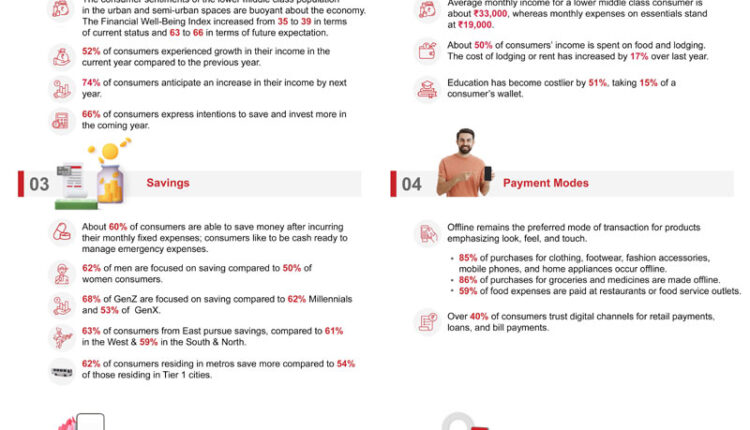Study Reveals Surging Confidence in Financial Well-Being; two-third consumers claim on saving and investing
- 74% of consumersexpect their incomes to increase by next year, and about two-thirds claim that they will be able to save more (66%) and invest more (66%) in the coming year.
- Hyderabad has the highest personal monthly income (44k).
- For an average lower middle-class Indian, grocery (26%) and rent (21%) are the primary expenses.
- Local city travel, sightseeing, eating out, and cinema are the key mediums for recreation that the urban middle class indulge.
- 42% of consumers foresee the potential usage of credit on UPI, a concept that enables a user to access instant credit directly through their UPI-enabled apps.
- 24% of consumers expect to use UPI Lite in future for small value transactions.
- 53% of consumers feel that primary motivation for adopting Credit on UPI lies in its time-saving capabilities, streamlining the loan process and reducing administrative hassles, while 44% feel that it makes shopping easier.
- Some consumers wouldn’t prefer using “Credit on UPI” as they feel the chances of falling into a debt trap is easier (31%), and apprehensive about overspending (28%), higher interest rates (24%), higher processing and other charges (7%).
- 64% will stop using the UPI service if it becomes chargeable.
New Delhi, 22 May 2024:Home Credit India (HCIN), a local arm of the leading global consumer finance provider, released the second edition of its in-house annual consumer survey – The Great Indian Wallet Study: Consumer behaviour towards key financial aspects.
The Great Indian Wallet study was conducted across 17 cities including Delhi-NCR, Mumbai, Kolkata, Chennai, Bengaluru, Hyderabad, Ahmedabad, Pune, Lucknow, Jaipur, Bhopal, Patna, Ranchi, Chandigarh, Dehradun, Ludhianaand Kochi. The sample size was approx. 2500 in the age group of 18-55 years, with an annual income between Rs. 2 lakhs to Rs 5 lakhs.
Speaking on the findings, Ashish Tiwari, Chief Marketing Officer, Home Credit India, said: “The Great Indian Wallet study serves as our compass, guiding us through the intricate landscape of consumer financial behaviour each year. By delving into the underlying behavioural trends, we gain valuable insights into household financial stability and the potential risks associated with technology in financial transactions. This year’s study reflects an upswing in the overall Financial Well-Being among urban and semi-urban consumers due to the strong economic growth, providing a clear insight into consumer sentiments, spending patterns, and saving habits among various demographics and segments.”
As per The Great Indian Wallet study, the Financial Well-Being Index among urban and semi-urban consumers has increased over last year, both in terms of current status and future perception. 52%of the consumers said that their income increased in the current year over last year, while 74% of consumers expects their income to increase by the coming year. About two-thirds claim that they would be able to save more (66%) and invest more (66%) in the coming year. This buoyancy in consumer sentiment is fuelled by the upward growth trajectory in the economy, an increase in earning capacity, and a positive perception of income growth.
The study also provides an overview of the income and expenses among lower-middle-class individuals in 2024. On average, the personal monthly income of lower-middle-class individuals is around 33K, while monthly expenses standat 19K in 2024.The growth in income over the past year has kept pace with the increase in expenses.
In terms of Wallet Share, the study revealed that Grocery (26%) and Rent (21%) continues to be the primary expenses dominating the wallet share of the average lower-middle-class Indian. This is followed by Commute (19%), Children’s Education (15%), Medical Expenses (7%), Electricity Bills (6%), Cooking Gas (4%), and Mobile Bills (2%).
As for Discretionary Spends, distinct spending patterns among different demographics could be seen. Chennai leads in local travel/sightseeing (59%), eating outside (54%) and watching movies outside (55%) when compared to other metros. Lucknow, on the other hand, is the lowest spenderon local travel/sightseeing (17%) and eating outside (14%). Chennai also pays the highest rent (29%), while Kolkata and Jaipur pay the lowest (15%). Ahmedabad and Dehradun spend the least on fitness (1%). Bengaluru & Kochi spends the most on children’s education (23%). Dehradun tops in medical expenses (13%) but spends the least on children’s education (10%).
The study also indicates that in the last six months, almost 60% of people had purchased fashion products like apparels and accessories, with Gen Z showing a greater inclination towards purchasing fashion products and electronics.
Household Expenseswitness a notable uptick, with an average increase of 6%.In households with more than one earning member, the chief wage earner (CWE) contributes ~80% of the total household expenses, while non-CWE contributes ~20%.In the study, 42% of the women are CWE in their respective households.
In terms of Savings, ~60% of consumersprioritisebuilding a cash reserveto address emergency expenses after covering their monthly fixedexpenses. According to the study, Men (62%) outpace Women (50%) in savings. Similarly, Gen Z (68%) demonstrates a stronger inclination towards savings than Millennials (62%) and Gen X (53%). Regionally, consumers from the East exhibits higher savings rates (63%) compared to those from the West (61%), South (59%), and North (59%). Furthermore, metros led in savings, with 62% of urban consumers prioritising savings over Tier 1 (61%) and Tier 2 (54%) cities.
As per the study, one-fifth of consumers;(21%) have been victims of Financial Fraud. Cities such as Delhi, Kolkata, Hyderabad, and Pune report a higher prevalence of financial fraud incidents.Men, Gen Z, and consumersfrom the North recalled receiving frequent fraudulent calls and messages over the past months. The study also revealed that 19% of consumersstoretheir financial data on their smartphones, while 24% shared such sensitive data with their friends and family, indicating a complacent approach to data security. Interestingly, Women, Gen Z, and residents of the South region exhibit higher levels of complacency in this matter.
In the realm of digital transactions, UPI (Unified Payments Interface) remains a focal point, warranting heightened vigilance and security measures to mitigate the risk of financial fraud.The study indicates that 72% are current users of UPI, with most usage among men, Gen Z, and metro residents. Notably, UPI usage is the highest in Chennai (90%) and lowest in Ahmedabad (58%).
Furthermore, the study shows that 42% of consumers, especially men, GenZ and Tier 1 consumers, expressed interest towards using Credit on UPI. Interestingly, the reasons to use “Credit on UPI” includesreduced timeframe in taking loans (53%), ease of payments at retail stores (44%), probability of getting better offers (23%), and lesser charges (16%).

